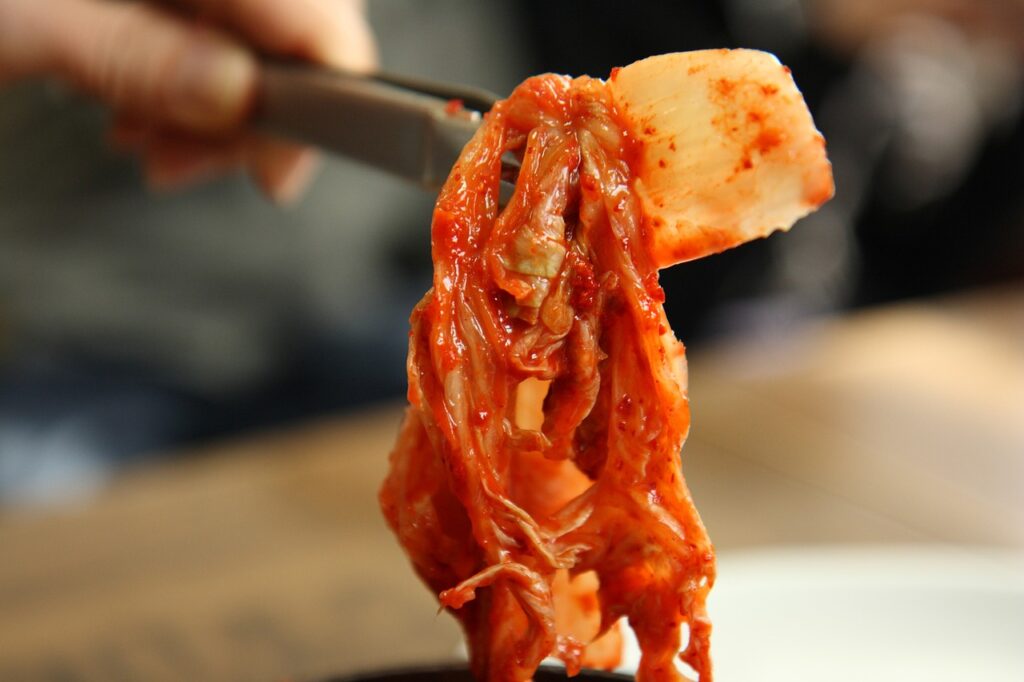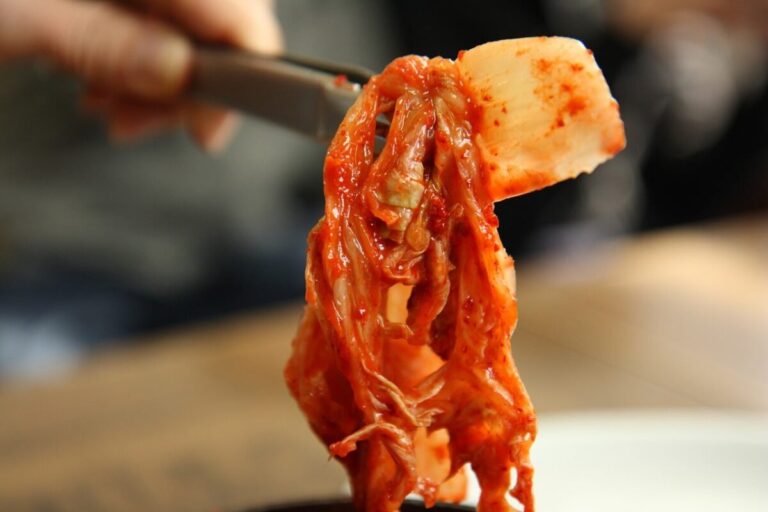
Does North Korea Have a National Dish?
North Korea doesn’t have an “official” national dish, but there are several dishes that are important to its culture and heritage. Food in North Korea is generally similar to that in South Korea, given that the two countries share a common history before their division in 1945. In this guide, we’ll focus on North Korean kimchi, otherwise known as “Pyonyang Kimchi.”
If you’re curious about other North Korean dishes, we’ll cover that in a later section.
Our team at Remitly created this guide as part of our series celebrating iconic cultural dishes worldwide.
Origins of Pyongyang Kimchi
The history of Pyongyang Kimchi is intertwined with the broader history of kimchi on the Korean Peninsula. Kimchi itself is an ancient dish, with origins dating back over a thousand years. However, different regions of Korea have their own unique styles and recipes for making kimchi, influenced by local climate, geography, and culinary traditions.
Pyongyang, the capital of North Korea, has its own distinct version of kimchi that reflects the characteristics of the region. In contrast to some other varieties of kimchi, such as those from the southern regions of Korea which may use more garlic, fish sauce, and are generally spicier, Pyongyang Kimchi is often milder and less spicy.
Historical Context
Traditionally, the climatic conditions in the northern regions of Korea, including Pyongyang, were less conducive to growing the variety of vegetables and spices found in the south. Additionally, the colder climate necessitated different preservation methods. As a result, the kimchi from the north traditionally used fewer ingredients and spices.
During the Joseon Dynasty (1392–1897), kimchi became a staple dish across Korea. Historical records indicate that various types of kimchi were enjoyed by both the royal family and commoners alike. While the royalty and aristocrats might have had the luxury of adding more diverse ingredients into their kimchi, commoners usually made do with what was locally available.
Cultural Importance
Kimchi is an integral part of Korean culture, and its importance is no less in North Korea. In fact, during the Kimjongilia Festival, a festival to celebrate Kim Jong-il’s birthday, kimchi has been displayed as an essential part of the nation’s culture.
Despite the political isolation of North Korea, kimchi remains a dish that connects the people to their heritage and traditions.
Recipe Evolution
The recipe for Pyongyang Kimchi may have evolved over time, particularly after the Korean War and the division of Korea. The economic conditions and sanctions imposed on North Korea have made certain ingredients more scarce, potentially affecting the traditional recipe.
Nevertheless, the essence of Pyongyang Kimchi has remained: a focus on simple, clean flavors that allow the quality of the vegetables to shine.
Today’s Pyongyang Kimchi
Today, Pyongyang Kimchi is still made in homes, restaurants, and even mass-produced in factories. It may not have the international fame that South Korean kimchi enjoys, but it remains a vital part of North Korean culinary tradition and cultural identity.
The Art of Fermentation: How Kimchi is Made
Kimchi is made through a process of fermentation, which gives it its unique tangy flavor. The fermentation process is done using lactic acid bacteria, which are naturally present on the cabbage and other vegetables used in the recipe.
The first step in making kimchi is to salt the cabbage and other vegetables to draw out the excess moisture. This helps to create the perfect environment for the lactic acid bacteria to thrive. The vegetables are then rinsed and mixed with a variety of spices, including red pepper flakes, garlic, ginger, and fish sauce.
The mixture is then packed into a jar or container and left to ferment for several days or even weeks, depending on the desired flavor. During the fermentation process, the lactic acid bacteria break down the sugars in the vegetables, producing lactic acid, which gives kimchi its distinct taste.
North Korean-Style Kimchi Recipe
While the basic concept of kimchi remains the same throughout the Korean Peninsula, North Korean kimchi (often called “Pyongyang Kimchi”) tends to be milder, less spicy, and sometimes a bit sweeter than South Korean varieties. It commonly features a clear and clean taste, focusing on the natural flavors of the vegetables.
Here’s a simplified recipe for North Korean-style Kimchi:
Ingredients:
- 1 medium Napa cabbage
- 1/4 cup sea salt
- 4 cups water
- 1 small daikon radish, thinly sliced
- 1 carrot, thinly sliced
- 4 green onions, chopped
- 1 small apple or pear, grated (for sweetness)
For the brine:
- 2 cups water
- 1 tablespoon sea salt
For the seasoning paste:
- 2-3 cloves garlic, minced
- 1 teaspoon ginger, minced
- 1 tablespoon sugar
- 1-2 tablespoons fish sauce (optional)
- 1 tablespoon soy sauce
- 1/2 tablespoon salt
- 1 tablespoon water
- 1/2 tablespoon sesame seeds (optional)
Instructions:
- Prepare the Cabbage: Cut the cabbage in half lengthwise and then into thirds. Soak the cabbage pieces in 4 cups of water and 1/4 cup of sea salt for about 1-2 hours to soften the leaves.
- Prepare the Brine: In a separate bowl, mix 2 cups water with 1 tablespoon of sea salt. Set aside.
- Rinse and Drain: After the cabbage has soaked, rinse it thoroughly under cold water three times. Make sure to drain it well, squeezing out any excess water.
- Prepare the Veggies: While the cabbage is soaking, prepare the daikon radish, carrot, and green onions. Set them aside.
- Prepare the Seasoning Paste: In a bowl, combine all the ingredients for the seasoning paste. Mix well.
- Combine: Take one leaf of the cabbage and spread a bit of the seasoning paste onto each leaf. Place some of the radish, carrot, and green onions onto the leaf. Move on to the next leaf and repeat until all leaves are seasoned.
- Layer and Store: Once all the cabbage leaves are seasoned and layered with other vegetables, tightly pack them into a glass jar or a traditional earthenware pot. Pour the brine over the cabbage, ensuring it is fully submerged. If needed, use a weight or a smaller jar filled with water to keep the cabbage submerged.
- Ferment: Allow the kimchi to ferment at room temperature for about 2-5 days, depending on your preference for fermentation level. Check the kimchi each day, pressing down on the vegetables to keep them submerged in the brine.
- Taste and Store: Once the kimchi has reached your desired level of fermentation, store it in the refrigerator. This will slow down the fermentation process. It’s best consumed within 2-3 weeks.
Health Benefits of Kimchi
Kimchi is not only delicious but also has several health benefits. The fermentation process produces probiotics, which are beneficial bacteria that help to promote gut health and boost the immune system.
Kimchi is also rich in vitamins and minerals, including vitamin C, vitamin K, and potassium. It is also low in calories and carbohydrates, making it a great addition to any healthy diet.
Kimchi Beyond Borders
Kimchi has become increasingly popular around the world, thanks to its unique flavor and health benefits. It has also inspired various culinary creations, such as kimchi fried rice, kimchi stew, and kimchi quesadillas.
Different countries have also put their own spin on the classic Korean dish. In Japan, for example, kimchi is often made with daikon radish and is milder in flavor than traditional Korean kimchi. In China, kimchi is often served as a side dish alongside hot pot, and in the United States, kimchi is being used in everything from tacos to grilled cheese sandwiches.
Kimchi has truly transcended borders, and its popularity continues to grow as more people discover its unique flavor and health benefits.
Learn More About North Korean Cuisine
Some more dishes that are considered representative of North Korean cuisine include:
- Naengmyeon: A cold noodle dish that is especially associated with Pyongyang, the capital of North Korea. Pyongyang naengmyeon is characterized by its chewy buckwheat noodles and a cold, clear broth often made from beef.
- Bulgogi: Although this dish is popular throughout the Korean Peninsula, it is also enjoyed in North Korea. It consists of marinated beef that is grilled or stir-fried.
- Various banchan: These are small side dishes that are served family-style. Common examples include various types of kimchi, pickled vegetables, and small fish.
- Tteok: Various types of rice cakes, which are often served during celebrations and holidays.
- Japchae: A dish made from sweet potato noodles, stir-fried with vegetables and meat.
- Mandu: Korean dumplings filled with a mixture of meats and vegetables.
Food can often be influenced by regional availability of ingredients, and this is true in North Korea as well. Given the country’s relative isolation, some dishes may have variations that are unique to North Korea.
It’s worth noting that North Korea faces significant food security issues, with periodic food shortages and famine. This, in turn, affects the availability and types of dishes that are commonly prepared.
Visit the homepage, download our app, or check out our Help Center to get started.
